We have prepared a detailed guide to Venice for you. Venice, a city floating on water, is one of the most romantic cities in Europe. Most of us remember the typical Venetian boats sailing along the canal. But Venice is full of charming streets, beautiful architectural treasures and art.
But Venice is also extremely popular and touristy, so it’s important to book accommodation early and ideally book tickets online for some of the sights. Read our article to the end and find out when to go to Venice, where to stay and what to see in our article.
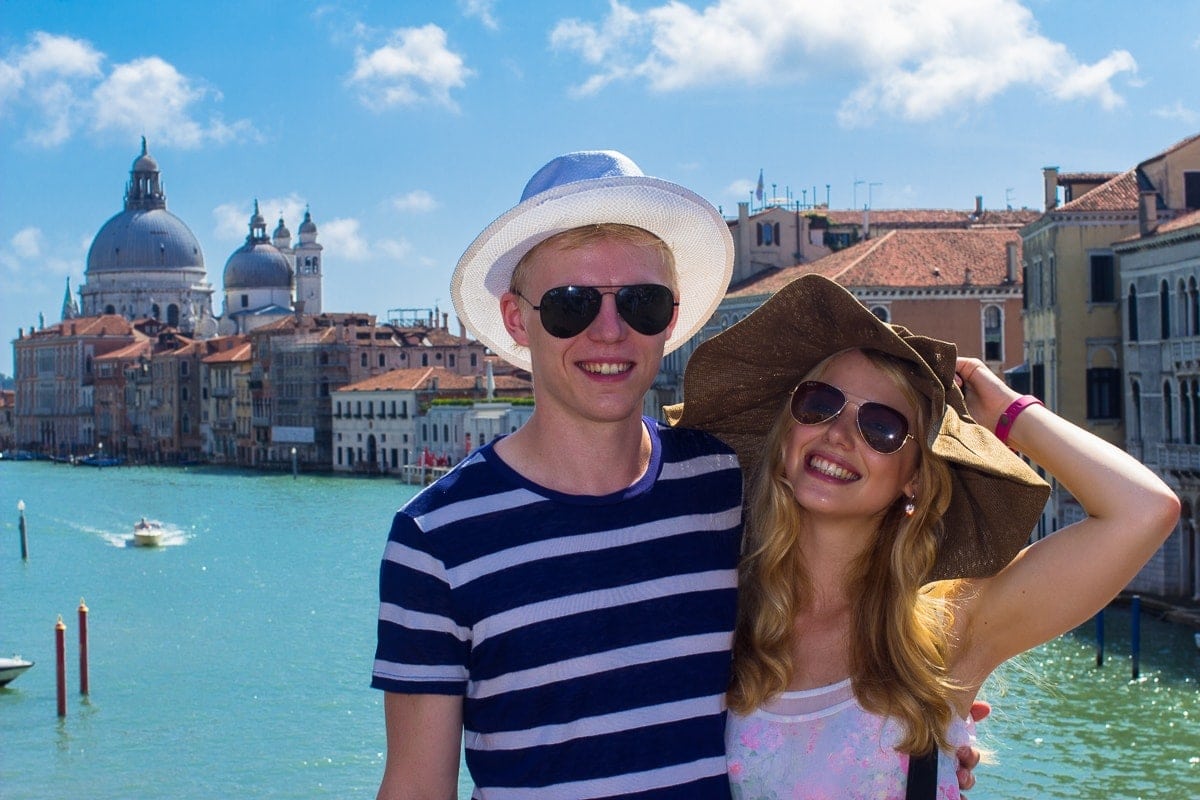
When to go to Venice: Weather in Venice
If you want to avoid the biggest crowd of tourists, but want pleasant weather, go in autumn – in September or October, or in spring – in April or May. If you want to see the carnival, you will have to choose a colder month – namely February. In summer, you can escape the heat on one of the local beaches.
| Moon | Average air temperature | Average water temperature |
| January | 6 °C | 11 °C |
| February | 8 °C | 10 °C |
| March | 12 °C | 10 °C |
| April | 16 °C | 12 °C |
| May | 21 °C | 17 °C |
| June | 24 °C | 20 °C |
| July | 27 °C | 22 °C |
| August | 27 °C | 25 °C |
| September | 23 °C | 24 °C |
| October | 18 °C | 20 °C |
| November | 11 °C | 17 °C |
| December | 7 °C | 14 °C |
How to get to Venice
Venice is easily accessible by car, train, bus or plane.
By car to Venice
It’s relatively easy to get from Prague to Venice:
- Take the A10 road through České Budějovice and then Austria. It’s a bumpy journey, taking just over 9 hours.
- Along the E45 road, past Pilsen to Germany and then through Austria to Italy. It’s a bit of a detour and you’ll spend almost 10 hours in the car.
By car from Brno you have three options:
- You’ll be there in 7 hours and 49 minutes on the A23, the fastest way to get there.
- The second option is not the fastest, but it is the most advantageous. It takes you along the S Autobahn via Vienna and Maribor, and you’ll be in Venice in less than 8 hours.
- You go to Vienna, then turn towards Salzburg. However, the journey is the longest, taking more than 9 hours.
Parking is forbidden in Venice: where to leave the car?
You cannot drive into Venice, so you must leave your car in one of the car parks listed below:
- On the island of Tronchetto – it is an artificial island with the largest number of parking spaces in Venice. You can always find a free parking space here and it is one of the cheaper options. All-day parking costs 22 euros.
- Garage in Piazzale Roma – it’s close to the centre, which you can walk to after parking. It’s best to book a garage in advance; all-day parking costs around 45 euros. For short-term parking, the S. Andrea Parking House is ideal, with a charge of 7 euros for every two hours.
- Suburbs of Mestre – you can park very cheaply, often for free, on the outskirts of Mestre. The downside is that it is quite far from the historic centre and you will have to use public transport, such as the train.
By train to Venice
From Prague or Brno it is best to go to Munich or Vienna, from where there are direct trains to Venice to the main station Santa Lucia. It takes approximately seven hours by train from both cities, or you can take the night trains and spend a few hours longer on the way.
By bus to Venice
You can also take a bus to Venice. Direct connections are offered by RegioJet, the journey from Prague takes 12.5 hours and tickets cost between CZK 1,200 and 2,000. The journey from Brno takes 9.5 hours. The company FlixBus offers connections with one transfer, the prices per ticket range from CZK 1,200 to CZK 3,000.
By plane to Venice
Direct flights from Prague to Venice are offered by Wizz Air and Ryanair. You can fly to one of two airports near Venice, Marco Polo and Treviso. Tickets cost on average 2 500 CZK. How to get airline tickets read here.
The Alilaguna line connects Venice with Marco Polo Airport and the journey will cost you 15 euros.
Transportation around Venice
Trains, buses and trams run between the centre of Venice and the suburb of Mestre. Venice itself, however, is on the water and no similar facilities are available. The centre of Venice can be conveniently explored on foot, but you can also use the city’s special transport – boats. These water buses are called vaporettos. For a truly authentic experience, you can also use a classic gondola.
Where can I get tickets for the vaporetto?
Tickets for all transport are available from the ferryman, ticket machines or newsagents. The Venezia Unica Card is a good value if you plan to spend several days in Venice. This card gives you a 72-hour pass for all water transport and buses, as well as access to selected museums and monuments.
Accommodation in Venice
Hotel in the historic centre of Venice
For exploring Venice, it’s definitely most convenient to stay in the centre itself. If price is your main concern, Residenza Ca’ San Marco and Casa Fenice are among the cheapest but still fairly well rated.
Those of you who prefer hotels with breakfast will probably choose Hotel Sant’Antonin or Ca’ Dei Dogi . The Londra Palace Venezia is one of the most luxurious accommodations in the city centre.
Cheap accommodation near Venice – Mestre
Mestre is in all respects cheaper than the centre of Venice, both in parking, travel and accommodation. If you want the easiest possible access to the centre and are only using Mestre for overnight stays, then find a hotel near the station – Hotel Trieste, for example .
Accommodation in Venice by the beach
Venice’s beaches aren’t usually the main tourist destination, but if you’re planning to swim in the sea and don’t want to go too far to the beach, look for hotels near Lido di Venezia or Lido di Jesolo. For example, check out the Almar Jesolo Resort & Spa or the cheaper Hotel & Residence Venezia 2000.
Accommodation in the Venetian Islands
Another option for accommodation is the Venice Islands. They are beautiful islands with an authentic atmosphere, while avoiding the busy centre. Among the best-rated hotels in Murano is the NH Collection Murano Villa. Beautiful hotels can also be found on the island of Burano, such as Casa sul Cielo di Burano.
How accommodation prices in Venice change throughout the year
Accommodation prices in Venice vary a lot throughout the year. The Venetian Carnival is held every February and all prices are significantly higher during this month, including accommodation. If the carnival itself isn’t your destination, then choose a different month of the year.
During the summer, mostly in July and August, prices can go up by almost half, as this is high season and Venice is visited not only by tourists from all over the world, but also by Italians. Another Venetian event is the Venice Film Festival held in August and September, so prices for services and accommodation are again higher. The cheapest accommodation in Venice is from October to the end of January.
Entrance fee to Venice
If you don’t stay in Venice itself, from 2023 onwards you will have to pay an entrance fee, which ranges from 3 to 10 euros, depending mainly on the season.
How long to go to Venice for?
You should go to Venice at least for a long weekend. We spent a whole week in Venice and we couldn’t say that we were bored. After you have visited all the sights and museums, you can explore the islands, as well as the local beaches.
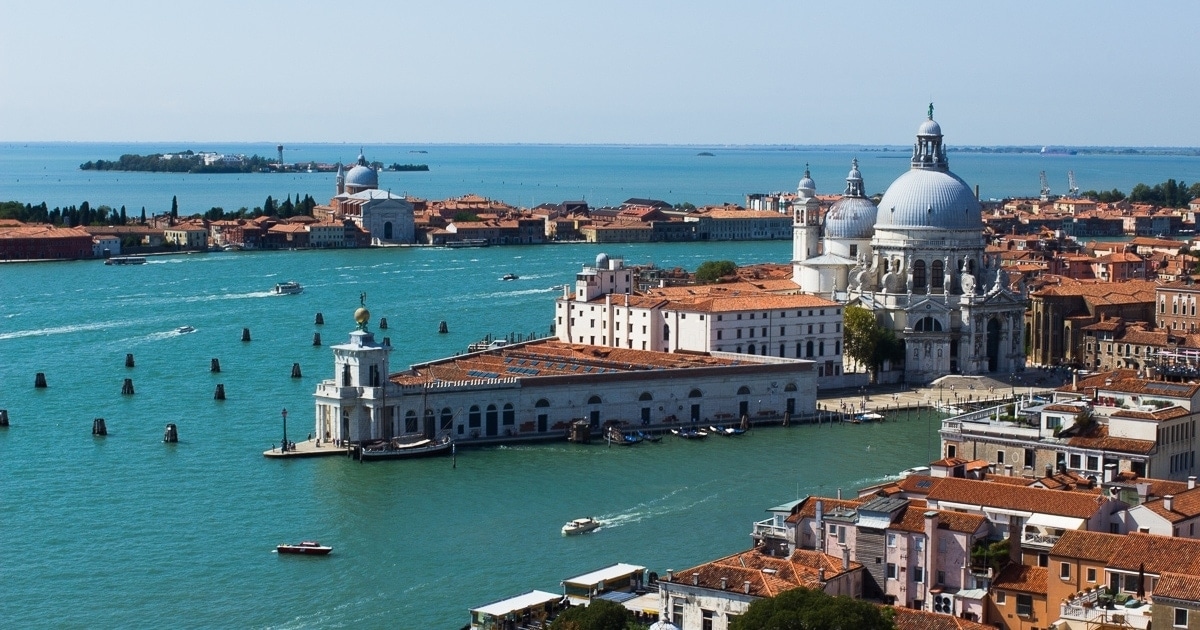
Map of Venice
Guide to Venice: what to do in the city?
Venice is a city where you won’t be bored, you can explore the beautiful architecture, explore the islands, and even go to the beach. But be sure to take a ride on the canal The famous Venetian boats, gondolas and vaporettos are a symbol of Venice for many tourists. These iconic boats play an important role in transport and tourism in this unique city on the water.
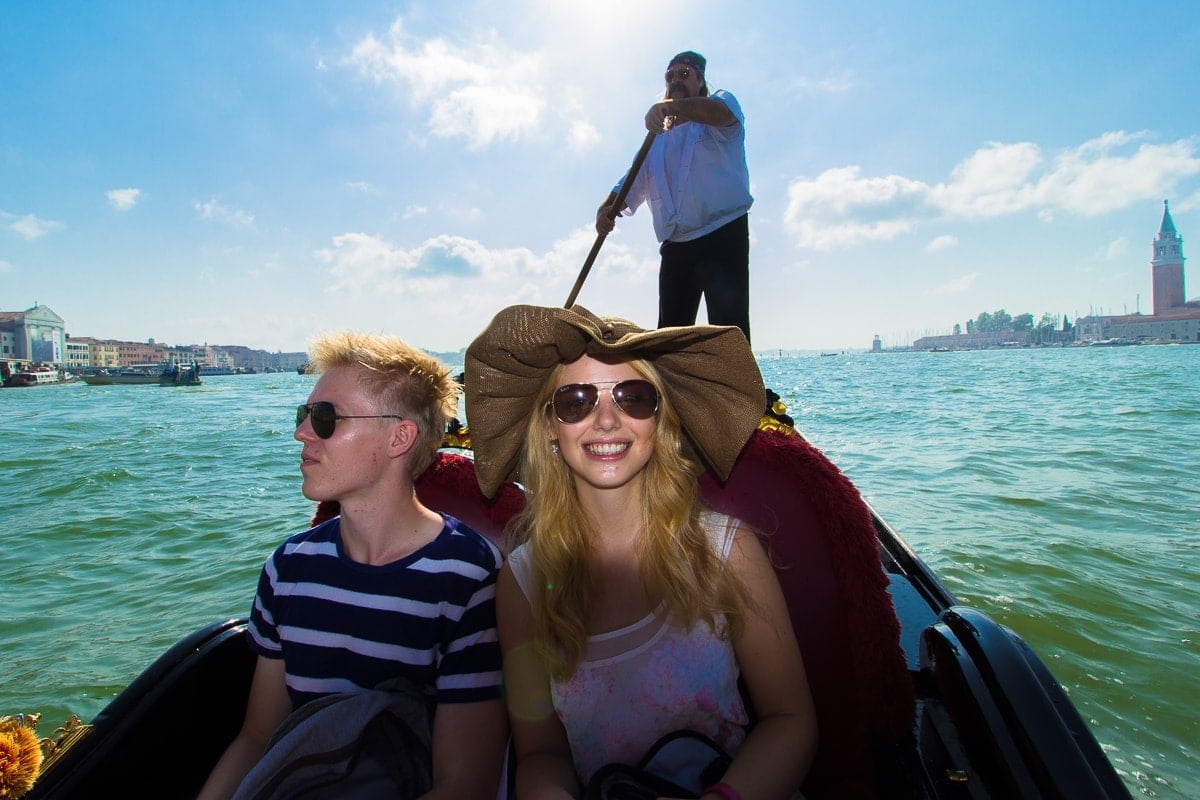
Gondolas are probably the most famous Venetian boat, symbolizing the romance and beauty of the city. These long and narrow boats with elegant curves were originally designed for water transport. Today they are mainly used for tourist purposes and offer romantic rides on the canals of Venice. The gondolier who drives the gondola usually still sings or plays the accordion. 🙂
Another type of boat is the Vaporetto. This boat is large and comfortable and offers transport around the entire lagoon, including the outermost islands such as Burano or Murano.
Although gondolas and vaporettos are perhaps the most famous boats in Venice, the city also has many other traditional boats, such as the “traghetto”, small gondolas that carry people across the Grand Canal, or the “bragozzo”, fishing boats used for catching fish in the lagoon. All these boats are an important part of Venetian culture and history and a visit to Venice would not be complete without a ride on one of these traditional boats.
The most beautiful places and monuments in Venice
Venice is an urban complex consisting of 118 islands connected by bridges and canals. The influence of European, Byzantine and Oriental art and architecture mixes here, creating a unique atmosphere and a perfect symbiosis of all these elements. Let’s see what you shouldn’t miss here.
Ponte di Rialto
Even those who have never been to Venice will remember the typical local historic bridges. Ponte di Rialto is the oldest and most famous of them all. In its present form it has existed since 16th century. The Grand Canal flows directly below it. In the arcade on the bridge, you can buy souvenirs from the trip in the many shops. The shops were established in the 15th century. century on the original wooden bridge, which later collapsed. Ponte di Rialto also appeared in the film Spiderman.
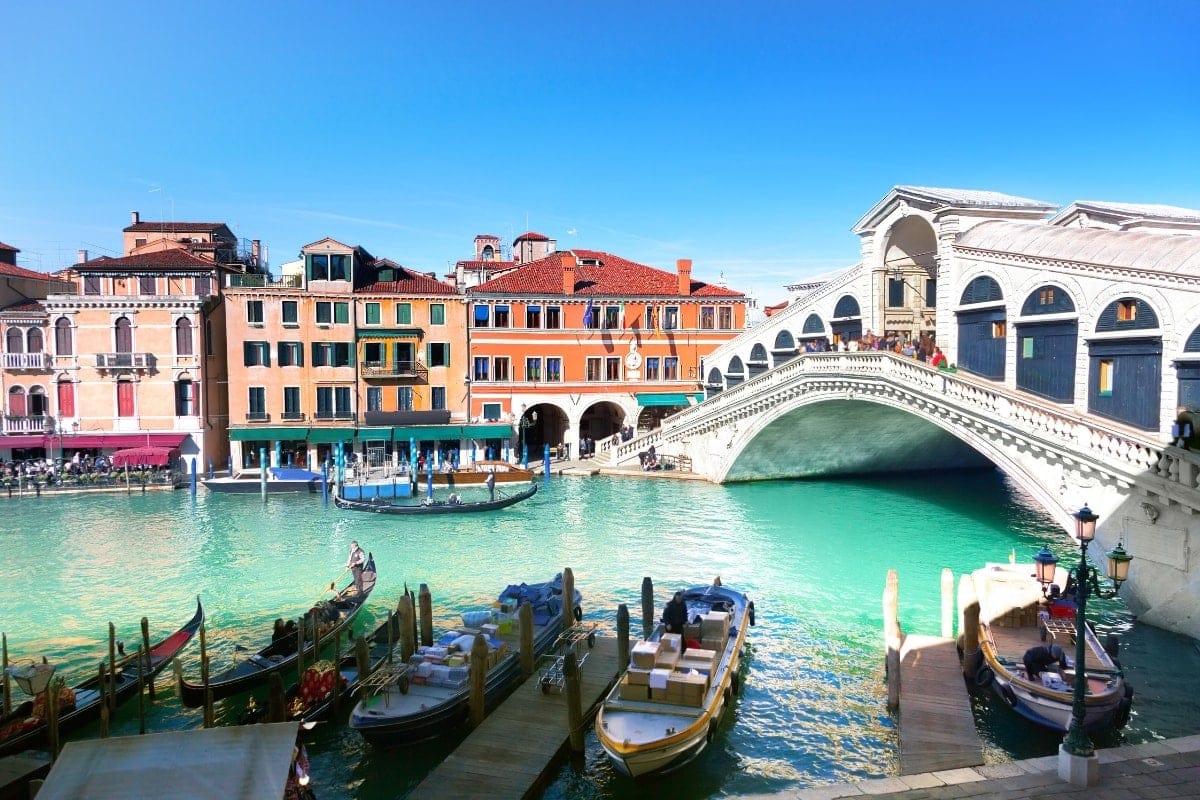
St. Brand
The main centre Venice is St. Brandfrom where you can reach all the most important sights. It is often the victim of floods, which are not uncommon in Venice. The square was named after the evangelist Mark, who became the patron saint of Venice.
Basilica of St. St. Mark’s – Temple of Gold
The most important monument of this town is the Basilica of St. Mark’s Church, Italian Chiesa (or also Basilica) di San Marco. It was built in the 9th century. century, when Venetian merchants buried the relics of St. Make. The church was later burnt down during the 976 uprising and a monumental basilica was built on its site a century later.
It was built in the Byzantine style, including later modifications from the 13th century. century. The basilica is decorated with many statues and columns, which came as booty from the Crusade of 1204. The façade is made up of five arches decorated with statues, ancient columns and rich mosaic decoration. Another important feature is the roof with five large domes.
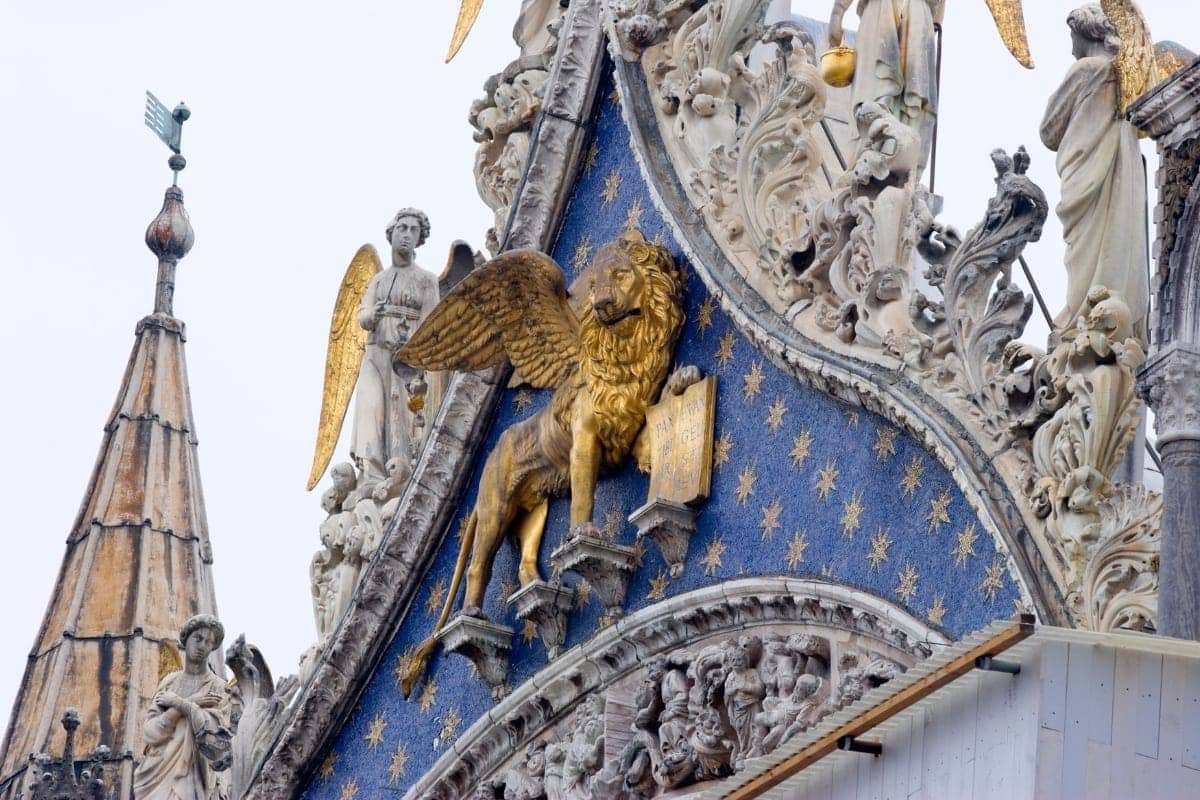
Not only the exterior is so richly decorated, the interior of the basilica is also impressive. Here you can admire a truly rich decoration of sculptures, paintings and mosaics. It is not for nothing that the basilica is nicknamed the “Temple of Gold”. If you want to make sure you get into the basilica, book your ticket in advance. We recommend using GetYourGuide like everywhere in Italy, where you can also use the “Skip the line” ticket that allows you to skip the queue.
The bell tower of St. St Mark’s (Campanile di San Marco)
Another monument named after the patron saint of Venice, the bell tower of St. Mark’s Basilica, standing right next to the basilica itself. It rises to a height of almost 99 metres, making it a landmark of Venice and hard to miss. The tower looks the same as in 16. century, but the original one collapsed and the current tower was built in 1912.
On the roof there is a statue of the archangel Gabriel. In addition to the five bells, there is also an observation deck at a height of about 60 metres, from which you can enjoy a breathtaking view of the whole of Venice. Above it is a stone lion – an attribute of St. Make.
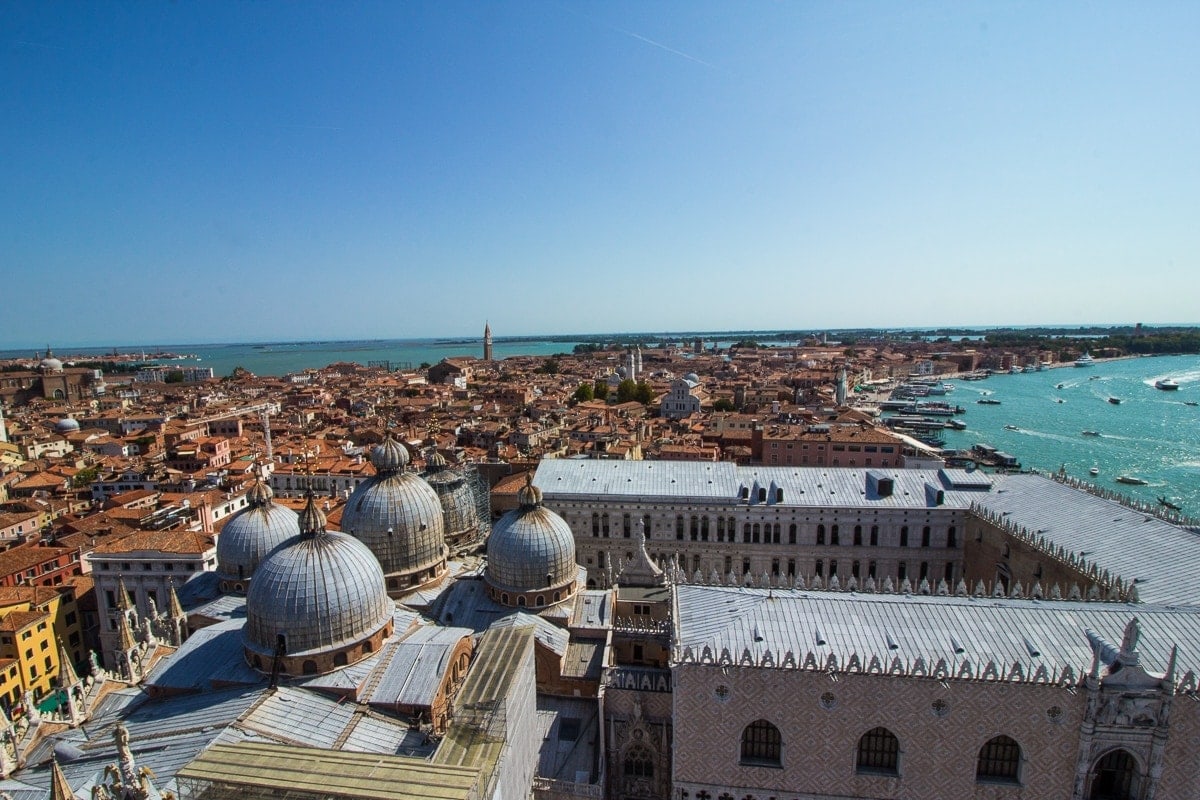
Doge’s Palace – Italian Palazzo Ducale
Another monument near St. St. Mark’s is the Doge’s Palace. The palace is built in the Venetian Gothic style, combining elements of both Byzantine and Gothic architecture. The interior is decorated with frescoes, ceiling paintings and Venetian furniture. The palace was built in 14. century and served as the residence of the Venetian rulers, or Doges. As with the Basilica, we recommend buying your ticket in advance via GetYourGuide.
The Venetian island of Murano
Murano is famous for its glass products. Glass has been produced here since 10. century, was part of the international trade of Venice. The glassmaking tradition in Murano continues to this day, and you can buy many interesting glass souvenirs here. Glassworks are part of the family homes as small family businesses. The Museum of Glass is worth a visit.
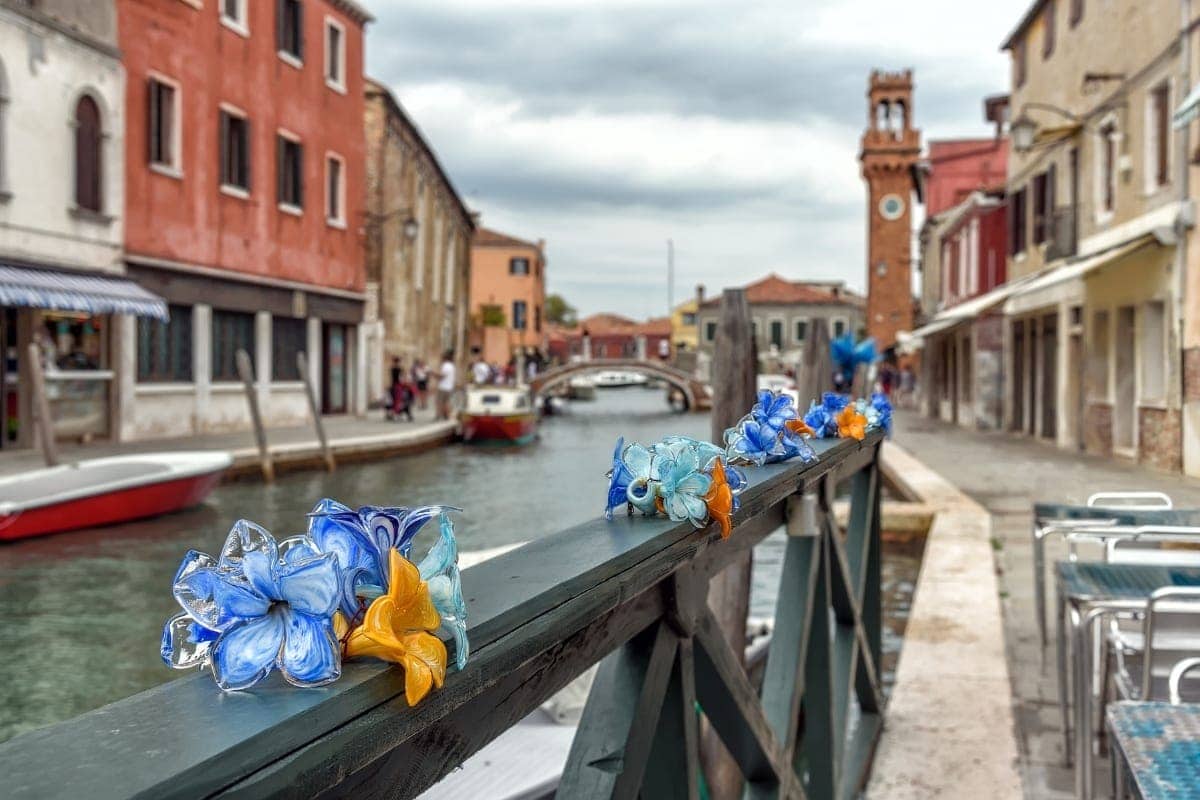
The Venetian island of Burano
Burano is best known for its colorful houses. According to the locals, this colouring of houses was introduced so that fishermen could easily find their homes after returning from the sea. Today, Burano is a popular tourist attraction and is also home to many fine lace-making workshops. You can visit the lace museum and see how lace is made, or buy some of the handmade lace as a souvenir.
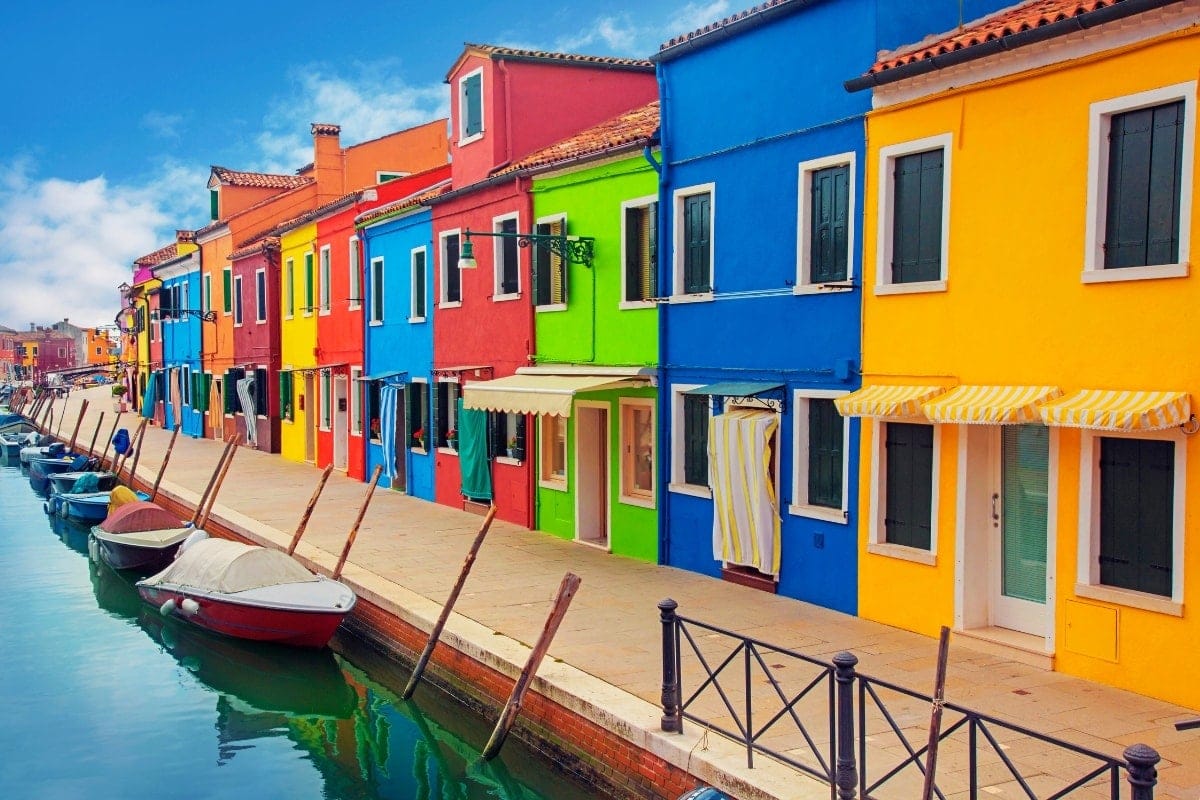
Island of San Giorgio Maggiore
San Giorgio Maggiore is another island belonging to Venice. You can see the basilica of the same name standing on it from afar. Especially interesting is the bell tower, which looks the same as the slightly higher bell tower of St. Make. The architect of the basilica was Palladius, who completed the building in 1566. The building strongly resembles the ancient style.
The interior of the basilica, decorated by the famous painter Tintoretto, is worth mentioning. To the west of the basilica stands a monastery from the 13th century. century. V 19. century, the monks were expelled from the monastery and had to leave the whole island at the same time, and the monastery became a military barracks and a weapons depot. It took almost a hundred years before the building was restored to its original owners.
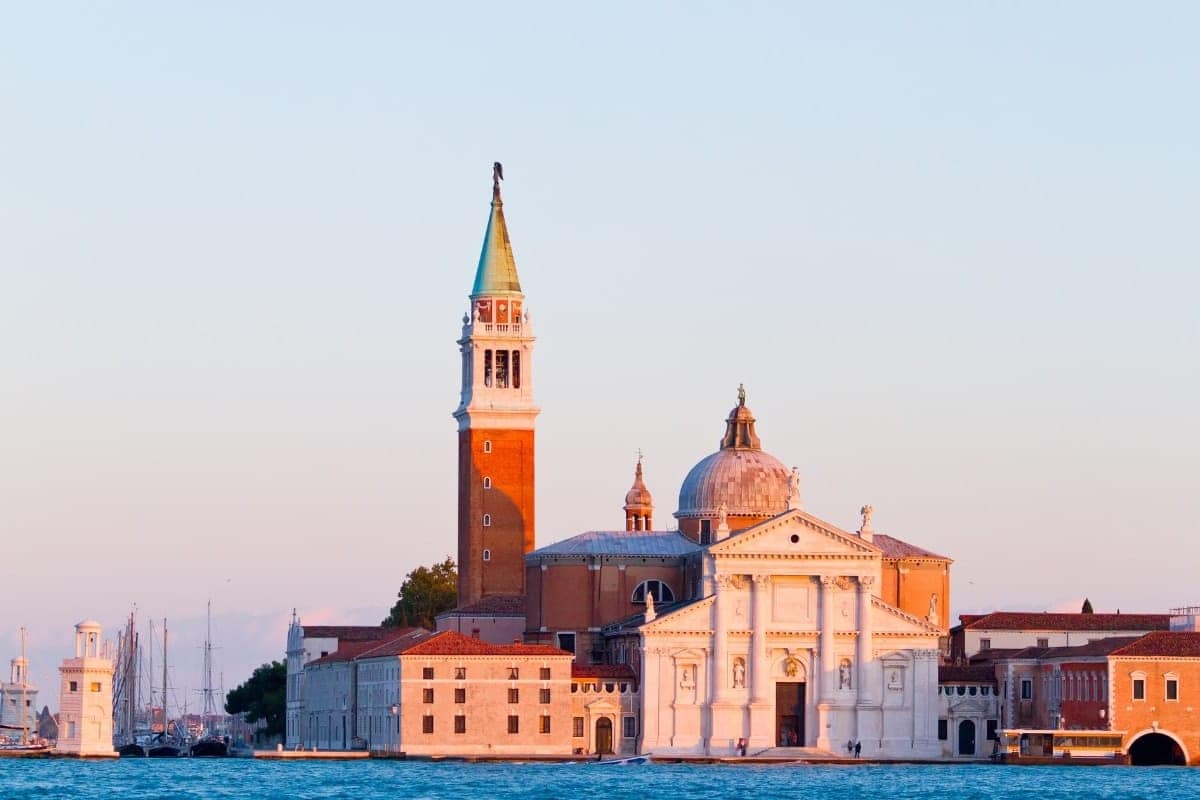
Island of San Michele
If you’re wondering where the dead are buried in a crowded Venice of stone streets and canals, the answer is on the island of San Michele. It serves as the only cemetery for the inhabitants of Venice. The island was first used as a burial place in the 15th century. century.
At first glance, it may not seem like an interesting stop on a trip to Venice, but it’s worth a short walk. From afar you will see the island surrounded by a thick wall, but inside you will find really beautiful buildings.
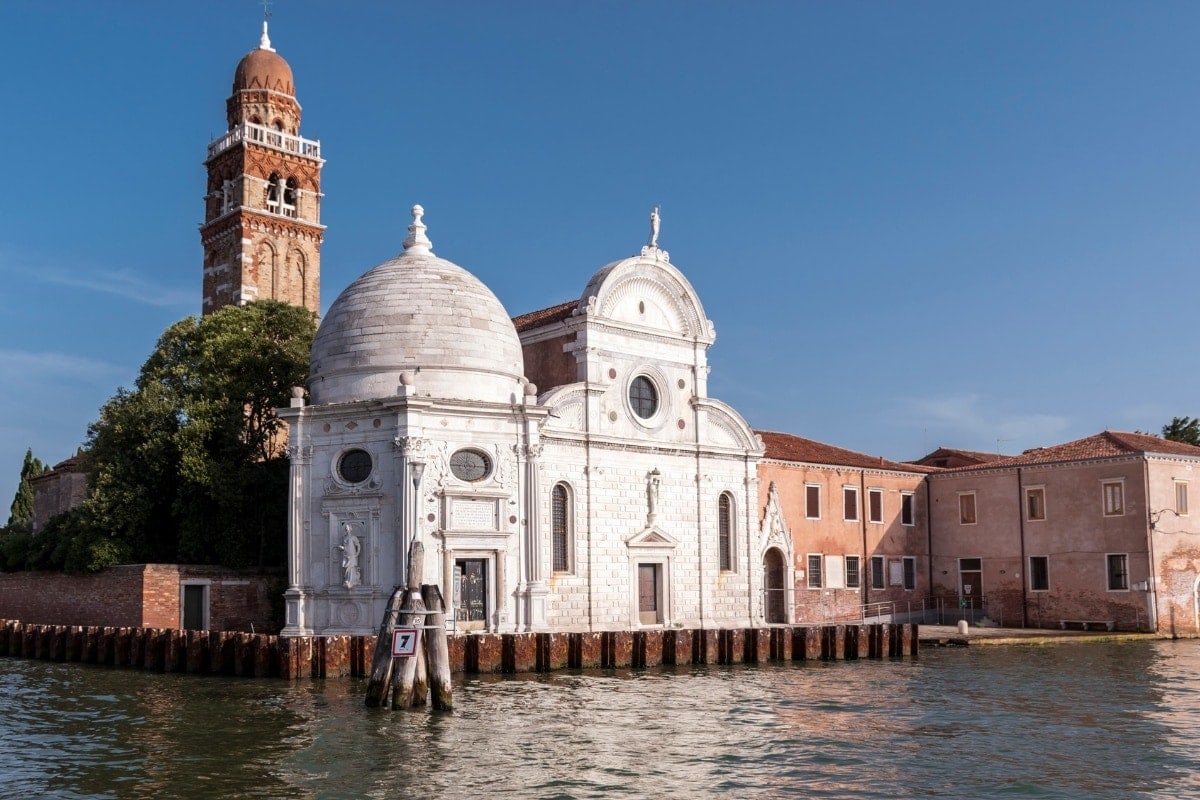
Grand Canal
The Grand Canal in Venice serves as a kind of “main road”, on which all public transport and cargo boats move. It is four kilometres long and can be crossed by four bridges, the most famous of which is the Ponte di Rialto bridge described above. KIf you look at the Grand Canal from a bird’s eye view, you’ll see that it is shaped like the letter S and stretches all the way through Venice.
Basilica dei Frari
At first glance, the church, which may seem austere, hides its richness especially inside. The façade is certainly not comparable to the richly decorated Basilica of St. Mark, but the interior attracts tourists with other riches. For example, the relics of several important personalities, such as Canova, Titian and the Venetian Doge Francesco Foscari, are kept here. But you will also find frescoes and paintings by artists such as the aforementioned Titian and Bellini.
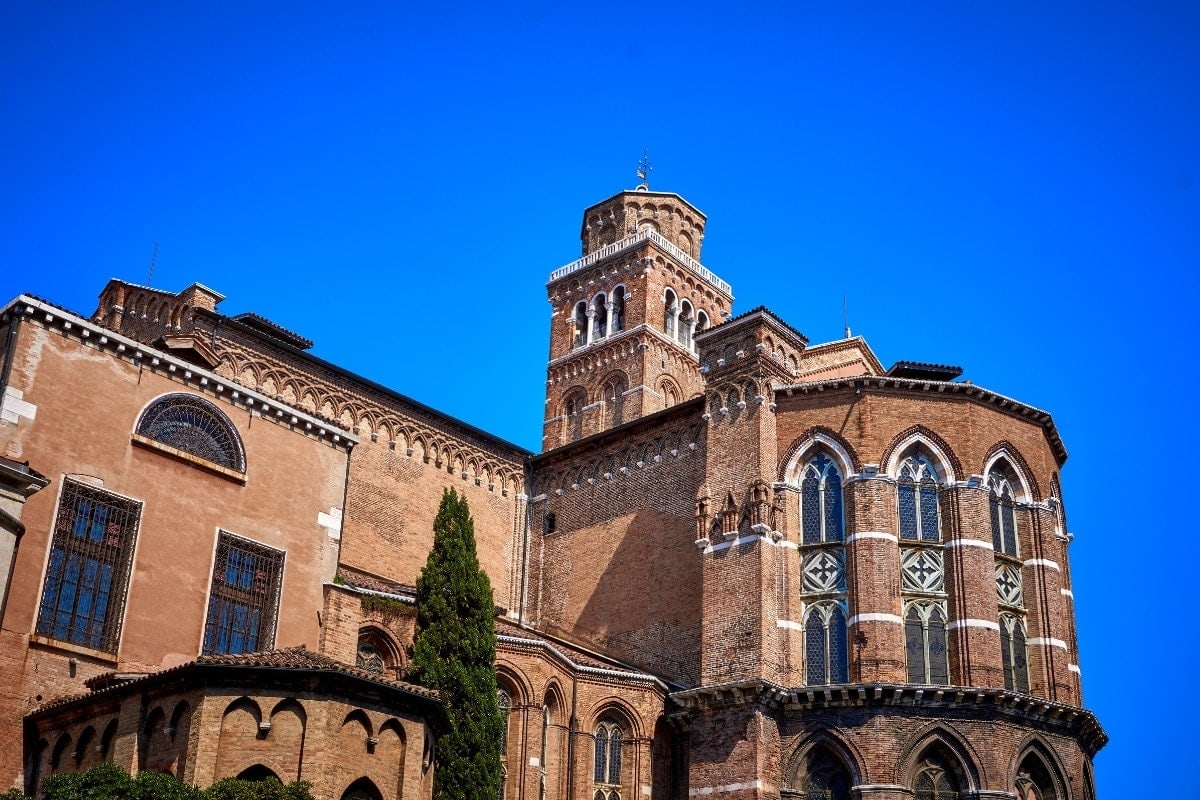
Santa Maria della Salute
Another Venetian basilica is Santa Maria della Salute near the Grand Canal. The basilica dates back to the 17th century. century and captivates every passer-by with its beauty. The two domes, one larger and one smaller, are made of white marble. The ceiling inside the basilica is decorated with paintings by Titian. The church is dedicated to the Virgin Mary and is one of the plague churches, it was built as a thanksgiving to the Virgin Mary after Venice was hit by a very strong and devastating plague epidemic.
The beaches in Venice can be found on the island of Lidio di Venezia
An island near Venice where you can find accommodation, supermarkets and restaurants. The main destination is, of course, the beaches. Here you can take a break from the constant hustle and bustle, the tourists and the high prices, but still see Venice and the Tower of St. Make. If relaxing on the sandy beaches gets too much for you, you can always simply take a trip to the historic town.
Ponte dei Sospiri
It is a small, 11-metre long bridge made of white limestone. Ponte dei Sospiri means “Bridge of Erections” after the sound made by convicts heading to the prison, which is connected to the Doge’s Palace on the other side of the canal. This name was given to the bridge in the 19th century. century, although the building itself was built as early as 1574.
Teatro la Fenice
At first glance, the theatre is not very striking and in fact hides one of the most famous scenes in the world. Well-known operas such as La Traviata, La Boheme, The Fallen Angels and Trancedi were premiered here. The scene was founded in 1755, the current building dates from 1792.
Palace – Golden House of Ca´d´Oro
The Golden House, Ca’ d’Oro, is one of the oldest Venetian palaces dating from the 15th century. century. Today it serves as an art gallery 15. – 18. century. Here you can see works by Antoine van Dyck, Andrea Mategna, Giovanni Bellini, Titian and others.
The tiny island of Torcello
Torcello is a tiny island, a 40-minute boat ride from the centre of Venice. But if you plan to spend a few days in Venice, don’t miss your trip. Today, about 30 people live in what was once the main centre of Venice. And you will find two main sights here:
- Cathedral of Santa Maria Assunta – dating back to the 7th century. century, inside the cathedral you will find beautiful Byzantine mosaics.
- Church of Santa Fosca – a beautiful Byzantine church from the 12th century. century.
Ponte dell Accademia
Ponte dell Accademia is a wooden bridge over the Grand Canal. It connects the central part of Venice with the southern part. The original bridge was demolished and the current wooden bridge was rebuilt in 1933.
Palazzo Contarini del Bovolo
The palace is located in the very centre of Venice and is one of the most interesting sights. You can climb the spiral staircase to the tower and enjoy the view of the city.
The most interesting museums in Venice
There are a number of museums in Venice that are well worth a visit, including:
Peggy Guggenheim Museum
If you know a bit about art, you’ve probably heard the name Peggy Guggenheim. Art collector Peggy Guggenheim’s gallery is one of the world’s most famous. The exhibition includes works of American and European art of the 20th century. century, e.g. Picasso, Pollock or Dali.
Museum in the Doge’s Palace
This imposing palace, which we have already mentioned above, was once the seat of the government of the Venetian Republic and today serves as a museum. In the palace you can see works of art, historical objects and visit rooms where important political decisions were made.
Accademia Gallery
This museum is home to the largest collection of Venetian art in the world, including works by Titian, Veronese and Canaletto. It is located in an impressive building by the Grand Canal.
Museo Correr
This museum is located in the building opposite the Doge’s Palace and contains collections that trace the history of Venice. Among the objects on display are religious artefacts, historical maps and portraits of Venetian rulers.
Palazzo Grassi Museum
Located in a beautiful palace on the Grand Canal, this museum contains collections of modern and contemporary art, including works by artists such as Andy Warhol and Damien Hirst.
Museo d’Arte Orientale
Located in a building near the Doge’s Palace, this museum houses a collection of Asian art. Among the objects on display are Japanese swords, Buddhist sculptures and ceramics from China.
What to bring back from Venice – souvenirs
- Lace – Venice is famous all over the world for its lace. You can see this traditional craft at the museum in Burano and then buy handmade lace in many shops around the city.
- Glassware – Head to the Venetian island of Murano and buy traditional glass beads, vases, figurines and more made by local glassmakers.
- Typical Venetian masks – Venice is also famous for its carnival masks, which come in many shapes, sizes and colours. These masks are considered a symbol of the city and can be purchased in many shops throughout the city.
- Bitter Orange Marmalade – This marmalade is made from bitter oranges that grow on trees in Venice (but are also popular in Spain). It is a traditional Venetian dessert served with crackers or cooked meat.
- Mosaics – Venice is famous for its traditional mosaics, so you can buy tiles, decorative panels and other items with mosaics as souvenirs.
- Coffee – Venice has a rich coffee culture, so you can buy local coffee in many cafes and specialty shops.
What to taste in Venice – typical Venetian specialities
One of the most famous Venetian dishes is “risotto al nero di seppia”, which is rice cooked with black cuttlefish, which gives this dish its typical dark colour. This dish is traditionally served with white wine and is one of the most popular dishes in Venice.
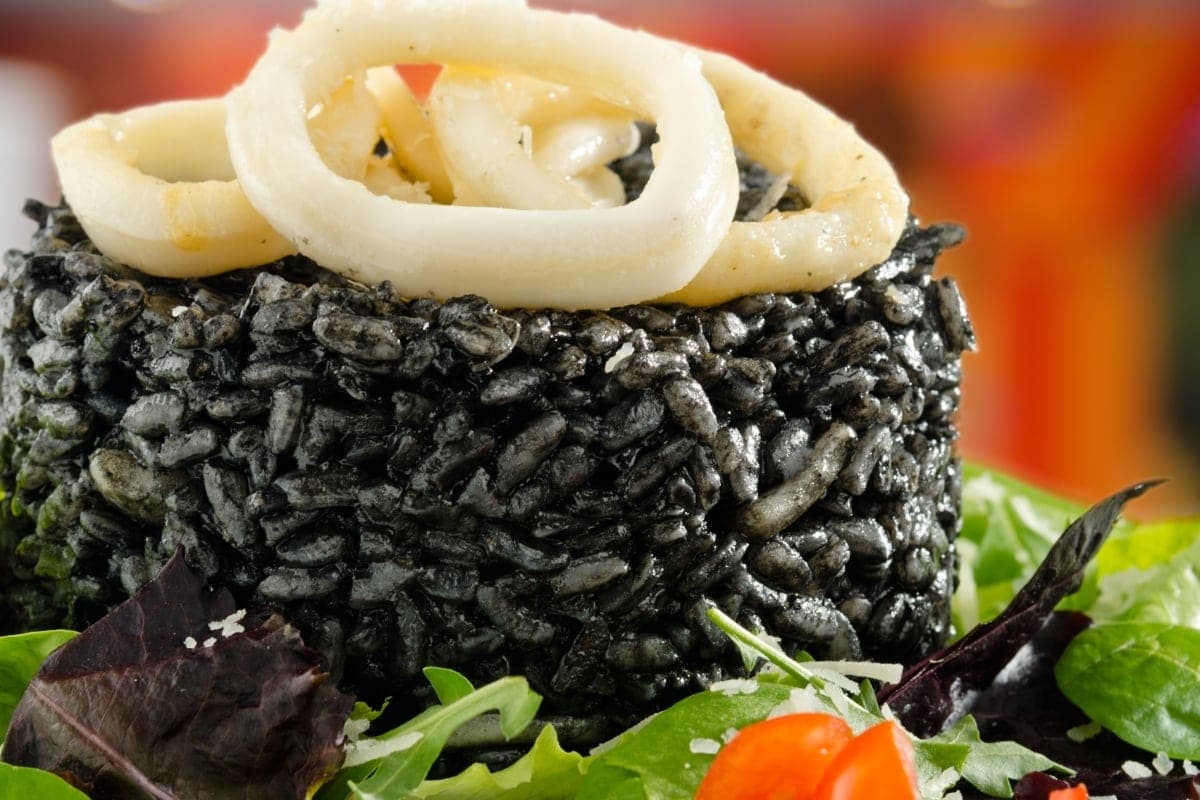
Another traditional dish is‘fegato alla veneziana’, liver pate with caramelised onions, served with polenta or rice. This dish is traditionally eaten for breakfast or lunch.
Venice is also famous for seafood such as prawns, mussels and octopus. Again, they are most often served with white wine and are cooked with olive oil, garlic and herbs to preserve as much of their natural flavour as possible.
The last traditional dish worth mentioning is“bigoli in salsa”, which is pasta with a sauce of onions, sardines and black olives. It is popular especially at Easter and during the carnival season.
Festivals and events in Venice
Carnival – its origins date back to the 11th century. century, it takes place during February and includes a ball in St. Make. The Venice Carnival is one of the most beautiful in the world.
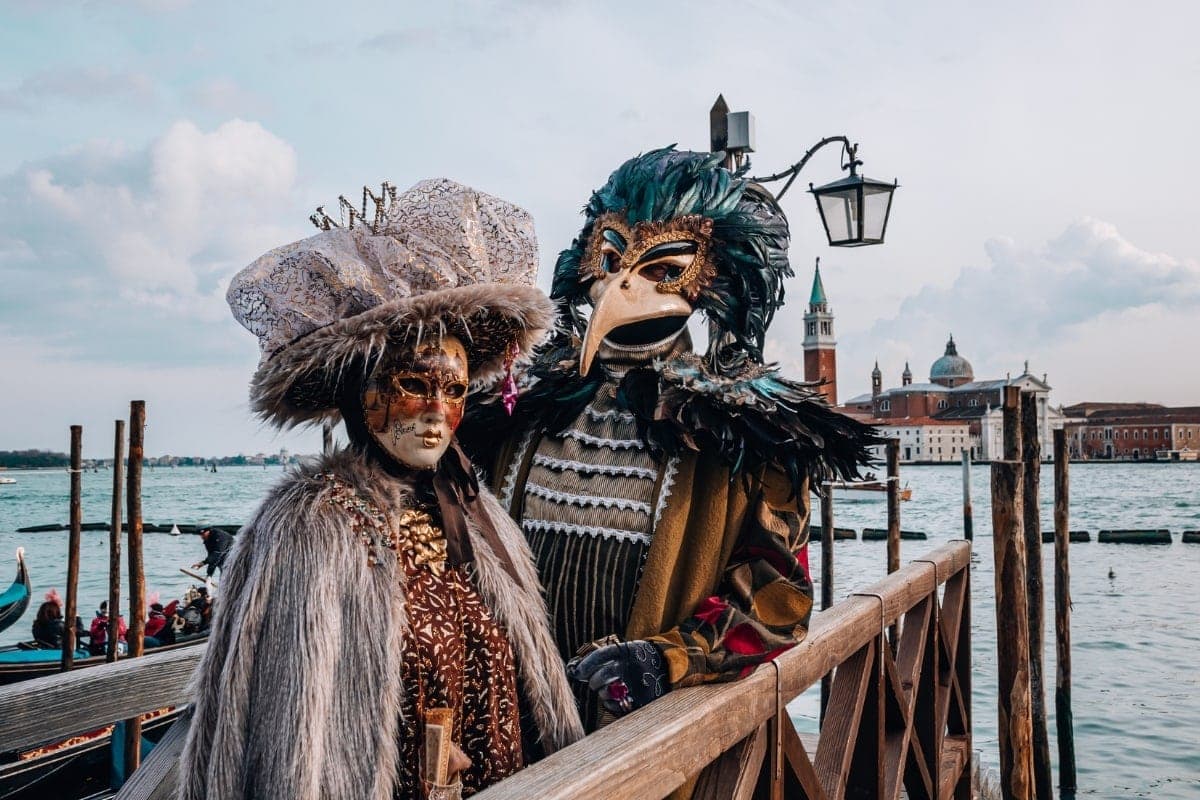
The Bienalle di Venezia exhibition. It is a biennial art show. Here you can admire contemporary art, not only fine art.
Another regularly held event is the Venice Film Festival, where the Golden Lion has been awarded since 1932. It takes place at the Palazzo del Cinema at the end of August and the beginning of September .
What films were shot in Venice?
- One Flew Over the Cuckoo’s Nest – Some scenes were filmed at the Gritti Palace Hotel in Venice.
- Casino Royale – Bond film from 2006, in which Daniel Craig first appeared as James Bond. There are several scenes filmed in Venice, including the famous scene where Bond destroys the Venedig house.
- Thieves or Two (The Tourist) – a 2010 romantic thriller starring Angelina Jolie and Johnny Depp, set in Paris and Venice.
- My Friend Monica (My Own Private Idaho) – a 1991 film directed by Gus Van Sant, set in the US and Europe, and including many scenes filmed in Venice.
- The Italian Job – a 1969 action film starring Michael Caine and Noel Coward, with some scenes filmed in Venice.

